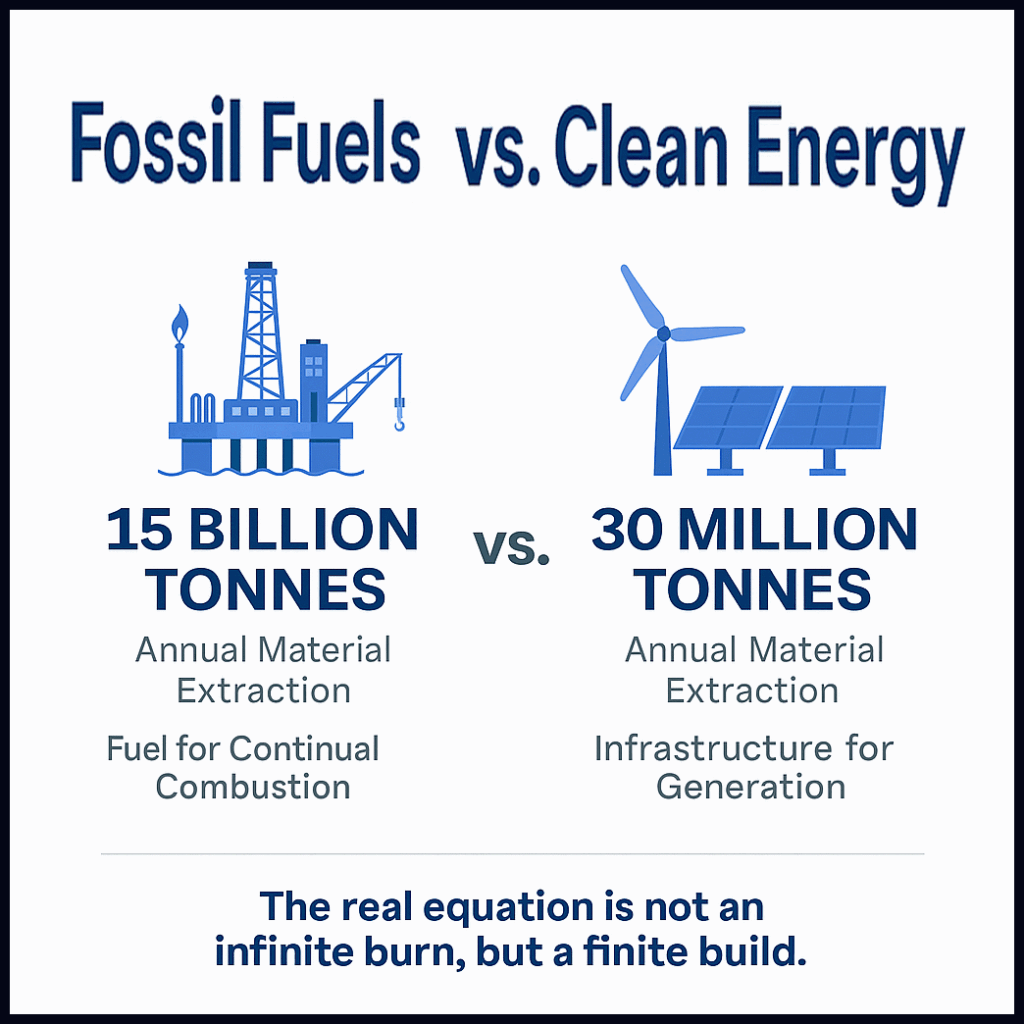Funded by fossil fuel lobbyists and amplified by legacy auto allies, disinformation campaigns aim to delay the clean energy transition by equating it with fossil fuels. These efforts exploit complexity and cherry-picked data to confuse the public and undermine progress.
One of the most persistent—and misleading—claims is that electric vehicles (EVs), solar panels, and wind turbines are just as environmentally damaging as fossil fuels because they require mining. This is a classic case of false equivalency—a logical fallacy that compares two things as if they are equal when, in fact, they are fundamentally different in impact, scope, and purpose.
Endless Extraction vs. One-Time Build
Fossil fuels are not just extracted once—they are consumed continuously. Every barrel of oil, ton of coal, or cubic metre of gas is extracted, burned, and gone forever. To maintain our fossil fuel addiction, the world extracts over 85 million barrels of oil per day, with similar ongoing operations in coal and gas. This never-ending cycle of extraction, combustion, and pollution is not just energy-intensive—it causes severe environmental harm.
Let’s break down the material footprint of the fossil economy:
- Coal: Over 8 billion tonnes are mined annually, mostly for electricity and steelmaking.
- Oil: At 85 million barrels/day, that’s ~4.5 billion tonnes of oil per year.
- Natural gas: Equivalent to 4 trillion cubic meters per year, with additional extraction for liquefaction and transportation.
In total, over 15 billion tonnes of fossil materials are extracted every year, not including the additional infrastructure (pipelines, refineries, drilling platforms, shipping) needed to maintain that flow. All of it is burned. All of it vanishes into the atmosphere as CO2, methane, NOx, and particulate pollution.
A Note on Nuclear Energy
While nuclear energy doesn’t emit carbon during operation, it shares some characteristics with fossil fuels in terms of large-scale, ongoing resource extraction—especially during construction. Nuclear power requires mining ~60,000 tonnes of uranium annually and significant quantities of concrete, steel, and rare earth elements to build and maintain plants.
However, unlike fossil fuels, uranium is not combusted daily in large volumes. Its fuel volume is far lower, and nuclear reactors operate for decades on relatively small quantities. The major concerns lie in radioactive waste management, high upfront material intensity, long project lead times, and public opposition due to safety risks.
Nuclear is not part of the infinite burn economy—but it remains a highly material-intensive form of energy, best compared with hydropower or geothermal in its fixed-infrastructure nature.
Clean Energy: Infrastructure, Not Fuel
In contrast, the materials used in the energy transition—lithium, cobalt, nickel, copper, graphite, manganese—are primarily used to build infrastructure. A solar panel, wind turbine, or battery is manufactured once, then used for decades. During their operational life, they generate clean, renewable electricity with no additional extraction required. Once deployed, they produce energy without burning fuel, emitting CO2, or polluting the atmosphere.
The total annual material requirement for the clean energy transition—estimated by the IEA and other studies—is about 25–30 million tonnes per year for lithium, cobalt, nickel, copper, graphite, manganese, and rare earths combined. Compare that to the 15 billion tonnes burned and gone from fossil fuels annually. The scale is not even in the same league.
And unlike fossil fuels, these materials are increasingly recyclable. Over 95% of battery-grade metals like nickel, lithium, cobalt, copper, manganese, and graphite can be recovered with modern techniques. Reuse and recycling will increasingly reduce future mining needs.

One-Time Build vs Eternal Burn
Consider this:
- A barrel of oil powers a car for around 500 km. After that, it’s gone.
- A solar panel generates power for 25 to 30 years, often covering the energy used in its manufacture in under 2 years.
This isn’t a difference in degree. It’s a difference in kind.
The Real Equation
| Metric | Fossil Fuels | Clean Energy |
|---|---|---|
| Extraction | Ongoing, infinite | Front-loaded, finite |
| Annual Material Use | ~15 billion tonnes | ~30 million tonnes |
| Emissions | High | Zero (in operation) |
| Energy Return | ~3–5:1 (declining) | 10–60:1 (solar/wind) |
| Waste | CO2, methane, air pollution | Mostly recyclable |
A Side-by-Side Reality Check
| Environmental Factor | Fossil Fuels | Clean Energy Materials |
|---|---|---|
| Annual Volume Extracted | ~15 billion tonnes/year | ~30 million tonnes/year |
| Usage Pattern | Burned once, then gone | Used in long-term infrastructure |
| CO₂ Emissions | ~35 billion tonnes/year | Near-zero during operation |
| Toxic Pollution | High (NOx, SO₂, PM2.5, spills, mercury) | Localized tailings; increasingly regulated |
| Water Use | Very high (fracking, refining, cooling) | Moderate, esp. in lithium brine extraction |
| Land Disruption | Widespread, long-term | Localized and mostly one-off |
| Recyclability | None (fuel is destroyed) | High (nickel, lithium, copper, cobalt, manganese, graphite > 95% recoverable) |
| Worker Safety | High fatality/pollution zones | Mixed; improving with ethical sourcing & traceability |
| Supply Chain Transparency | Often opaque, geopolitically volatile | Improving; ESG standards and traceability growing |
| Energy Return (EROI) | Low and falling (~3–5:1) | High and rising (solar 30–60:1, wind 20–50:1) |
Addressing Mining Concerns
Legitimate concerns exist around clean energy mining—especially when it comes to water use in lithium brine extraction, cobalt’s human rights issues in artisanal mines, and habitat disruption in mineral-rich regions. However, significant improvements are underway:
- Lithium: Direct Lithium Extraction (DLE) technologies are reducing water use and environmental impact. Increasing ESG pressure is also being applied to lithium mining globally, including in China, where regulatory scrutiny and environmental standards are tightening. Authorities are beginning to enforce stronger controls on water use, chemical discharge, and ecological disturbance, especially in response to growing domestic concerns over environmental degradation in resource-rich provinces.
- Cobalt: Supply chains are increasingly traceable, with major automakers phasing out cobalt or sourcing only from verified ethical suppliers. Artisanal cobalt mining in the Democratic Republic of Congo (DRC)—which supplies over 70% of the world’s cobalt—has drawn global attention for child labor and unsafe working conditions. In response, initiatives like the Cobalt for Development program and the Fair Cobalt Alliance are pushing for formalization, safety improvements, and education. Meanwhile, technological advancements and material innovation are enabling partial or full substitution of cobalt in batteries, helping reduce long-term reliance.
- Circular economy: Battery recycling is scaling fast, driven by both policy (e.g., EU Battery Directive) and economics.
- Current recycling rates: As of 2024, global lithium recycling rates have modestly improved, ranging between 7–12%, while nickel and cobalt recycling in industrial settings now exceed 55–60%. New commercial-scale battery recycling facilities in Europe, China, and North America continue progressing toward >90% recovery targets by 2030.
- Substitution: Lithium iron phosphate (LFP) batteries eliminate the need for cobalt and nickel entirely. They are now the dominant chemistry in China, powering over 80% of EVs produced as of 2024, thanks to their safety, long cycle life, and lower cost. While they offer slightly lower energy density compared to NMC chemistries, they are ideal for most use cases, especially in mass-market EVs and stationary storage. Sodium-ion batteries—while lower in energy density—offer even more abundant, low-cost alternatives without relying on lithium, cobalt, or nickel at all, and are well-suited to stationary applications and short-range EVs. Additionally, flow batteries, such as vanadium redox and zinc-bromine chemistries, are emerging as promising technologies for grid-scale storage, offering long cycle life, deep discharge capability, and low fire risk. These solutions diversify the clean energy storage mix and reduce pressure on critical mineral supply chains.
These solutions aren’t theoretical—they’re already being commercialized.
Visual Snapshot: Lifetime Material Footprint
A typical EV battery requires around 250–500 kg of materials to manufacture—used once and then recharged for years. In contrast, a gas-powered car burns through 20,000–25,000 kg of fuel over a decade. That’s the real footprint comparison.
But this isn’t just about material weight—it’s about energy conversion. EVs convert over 80% of the energy in their batteries into motion. Internal combustion engines? Just 20–25%. That inefficiency compounds the environmental cost of fossil fuel extraction and combustion.
So when we talk about sustainability, it’s not only a question of what goes into a vehicle, but how that energy is used over time. EVs offer not just lower emissions, but higher efficiency, greater long-term value, and a radically smaller operational footprint.

The Path Forward
The truth is simple: we are trading an infinite burn for a finite build. We’re replacing a system that destroys the climate every single day with one that gives us a chance at a livable future. Mining is not ideal, but neither is mass extinction.
This transition will require oversight, regulation, and responsibility—but it is the only viable path forward. As recycling technologies mature and circular supply chains expand, the need for new raw materials will shrink dramatically.
Call to Action: Support concrete initiatives like the EU Battery Regulation, which targets 90% battery recycling by 2027, and companies like Redwood Materials leading closed-loop battery supply chains. Demand traceable, ethical sourcing in supply chains and pressure automakers and policymakers to accelerate the global shift to clean infrastructure. The faster we build the clean energy future, the sooner we stop the burn. That’s the only equation that matters.
References
- International Energy Agency (IEA), “The Role of Critical Minerals in Clean Energy Transitions”
- European Commission, “Proposal for a Regulation on Batteries and Waste Batteries”
- Batteries News, “Battery recycling breakthrough achieves 99.99% lithium recovery”
- Transport & Environment, “Batteries vs Oil: A Comparison of Raw Material Needs”
- McKinsey & Company, “The raw-materials challenge: How the metals and mining sector will be at the core of enabling the energy transition”
- Visual Capitalist, “Visualizing the Products and Fuels Made from Crude Oil”
- International Renewable Energy Agency (IRENA), “Future of Wind” and “Future of Solar Photovoltaic”

